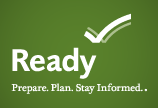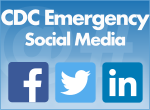Flood Water After a Disaster or Emergency

Inside the Home
- Keep children and pets out of the affected area until cleanup has been completed.
- Wear personal protective equipment, including rubber boots, rubber gloves, and goggles during cleanup of affected area.
- While cleaning up areas with mold damage, wear a NIOSH-approved N-95 respirator, or one that provides even more protection.
- Remove and discard items that cannot be washed and disinfected (such as, mattresses, carpeting, carpet padding, rugs, upholstered furniture, cosmetics, stuffed animals, baby toys, pillows, foam-rubber items, books, wall coverings, and most paper products).
- Remove and discard drywall and insulation that has been contaminated with sewage or flood waters.
- This should include material that are located a foot higher than the high water line.
- Thoroughly clean all hard surfaces (such as flooring, concrete, molding, wood and metal furniture, countertops, appliances, sinks, and other plumbing fixtures) with hot water and laundry or dish detergent.
- Help the drying process by using fans, air conditioning units, and dehumidifiers.
- After completing the cleanup, wash your hands with soap and clean water.
- Wash all clothes worn during the cleanup in hot water and detergent. These clothes should be washed separately from uncontaminated clothes and linens.
- Wash clothes contaminated with flood or sewage water in hot water and detergent. It is recommended that a laundromat be used for washing large quantities of clothes and linens until your onsite waste-water system has been professionally inspected and serviced.
- Seek immediate medical attention if you become injured or ill.
See also Reentering Your Flooded Home , Mold After a Disaster , and Cleaning and Sanitizing With Bleach after an Emergency.
Outside the Home
- Keep children and pets out of the affected area until cleanup has been completed.
- Wear rubber boots, rubber gloves, and goggles during cleanup of affected area.
- Have your onsite waste-water system professionally inspected and serviced if you suspect damage.
- Wash all clothes worn during the cleanup in hot water and detergent. These clothes should be washed separately from uncontaminated clothes and linens.
- After completing the cleanup, wash your hands with soap and clean water. Use water that has been boiled for 1 minute (allow the water to cool before washing your hands); or you may use water that has been disinfected for personal hygiene use:
- When using 5-6% unscented liquid household chlorine bleach – add a little less than 1/8 teaspoon (8 drops or about 0.5 milliliters) per 1 gallon of clear water. Stir well, and let it stand for 30 minutes before using. If the water is cloudy, add a little less than ¼ teaspoon (16 drops or about 1 milliliter) per 1 gallon of water.
- When using 8.25% unscented liquid household chlorine bleach – add a little less than 1/8 teaspoon (6 drops or about 0.5 milliliters) per 1 gallon of clear water. Stir well, and let it stand for 30 minutes before using. If the water is cloudy, add 12 drops (or about 1 milliliter) per 1 gallon of water.
- Seek immediate medical attention if you become injured or ill. See wound care for more information.
Health Risks
Flood waters and standing waters pose various risks, including infectious diseases, chemical hazards, and injuries.
Infectious Diseases
Diarrheal Diseases
Eating or drinking anything contaminated by flood water can cause diarrheal disease (such as E. coli or Salmonella infection). To protect yourself and your family:
- Practice good hygiene (handwashing with soap and water) after contact with flood waters.
- Do not allow children to play in flood water areas.
- Wash children’s hands with soap and water frequently (always before meals).
- Do not allow children to play with toys that have been contaminated by flood water and have not been disinfected.
- For information on disinfecting certain nonporous toys, visit CDC Healthy Water’s Cleaning and Sanitizing with Bleach section.
Wound Infections
Open wounds and rashes exposed to flood waters can become infected. To protect yourself and your family:
- Avoid exposure to flood waters if you have an open wound.
- Cover clean, open wounds with a waterproof bandage to reduce chance of infection.
- Keep open wounds as clean as possible by washing well with soap and clean water.
- If a wound develops redness, swelling, or oozing, seek immediate medical attention.
- Vibrios are naturally occurring bacteria that live in certain coastal waters. They can cause a skin infection when an open wound is exposed to salt water or a mix of salt and fresh water, which can occur during floods.
Seek medical attention as soon as possible if:
- There is a foreign object (soil, wood, metal, or other objects) embedded in the wound;
- The wound is at special risk of infection (such as a dog bite or a puncture by a dirty object);
- An old wound shows signs of becoming infected (increased pain and soreness, swelling, redness, draining, or you develop a fever).
For more information, visit CDC’s Emergency Wound Care After a Natural Disaster .
Chemical Hazards
Be aware of potential chemical hazards during floods. Flood waters may have moved hazardous chemical containers of solvents or other industrial chemicals from their normal storage places.
Injuries
Drowning
Flood water poses drowning risks for everyone, regardless of their ability to swim. Swiftly moving shallow water can be deadly, and even shallow standing water can be dangerous for small children.
Vehicles do not provide adequate protection from flood waters. They can be swept away or may stall in moving water.
Animal and Insect Bites
Flood waters can displace animals, insects, and reptiles. To protect yourself and your family, be alert and avoid contact.
Electrical Hazards
- NEVER touch a fallen power line. Call the power company to report fallen power lines.
- Do not drive through standing water if downed power lines are in the water.
- If you believe someone has been electrocuted, call or have someone else call 911 or emergency medical help.
- After a hurricane, flood or other natural disaster you need to be careful to avoid electrical hazards both in your home and elsewhere.
- Avoid contact with overhead power lines during cleanup and other activities.
- Protect Yourself and Others From Electrical Hazards After a Disaster
Wounds
Flood waters may contain sharp objects, such as glass or metal fragments, that can cause injury and lead to infection.
Resources and Guidance
- Page last reviewed: October 6, 2017
- Page last updated: October 6, 2017
- Content source:


 ShareCompartir
ShareCompartir

